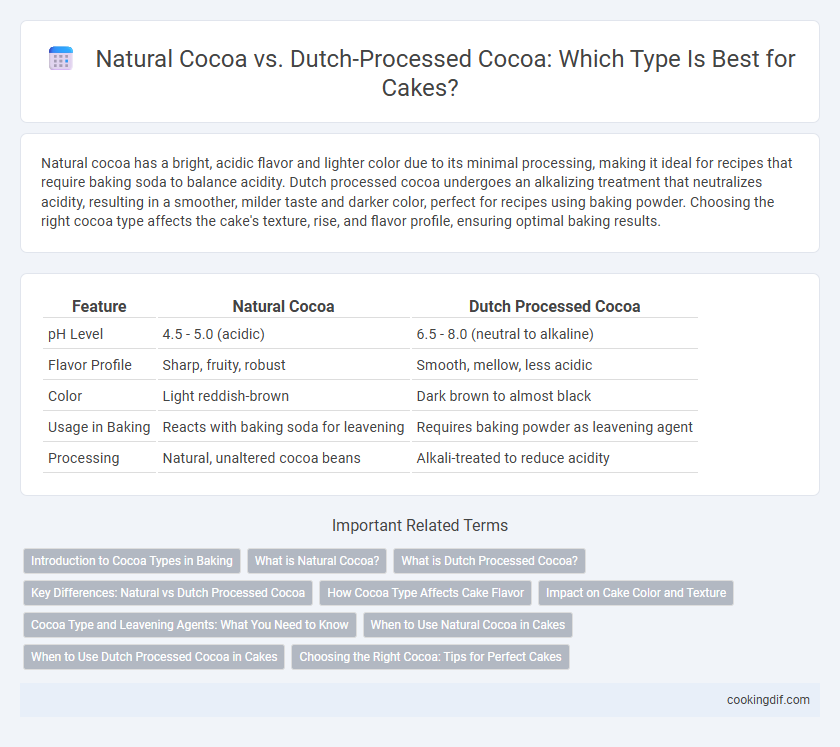Natural cocoa has a bright, acidic flavor and lighter color due to its minimal processing, making it ideal for recipes that require baking soda to balance acidity. Dutch processed cocoa undergoes an alkalizing treatment that neutralizes acidity, resulting in a smoother, milder taste and darker color, perfect for recipes using baking powder. Choosing the right cocoa type affects the cake's texture, rise, and flavor profile, ensuring optimal baking results.
Table of Comparison
| Feature | Natural Cocoa | Dutch Processed Cocoa |
|---|---|---|
| pH Level | 4.5 - 5.0 (acidic) | 6.5 - 8.0 (neutral to alkaline) |
| Flavor Profile | Sharp, fruity, robust | Smooth, mellow, less acidic |
| Color | Light reddish-brown | Dark brown to almost black |
| Usage in Baking | Reacts with baking soda for leavening | Requires baking powder as leavening agent |
| Processing | Natural, unaltered cocoa beans | Alkali-treated to reduce acidity |
Introduction to Cocoa Types in Baking
Natural cocoa contains a sharp, fruity acidity with a lighter color and is commonly used in recipes with baking soda to balance its pH. Dutch processed cocoa undergoes an alkalization treatment that neutralizes acidity, resulting in a smoother flavor and darker color, making it ideal for recipes calling for baking powder. Understanding these differences allows bakers to select the appropriate cocoa type to achieve desired texture, taste, and color in cake recipes.
What is Natural Cocoa?
Natural cocoa is derived from cocoa beans that are simply roasted, ground, and sifted without alkalizing treatment, preserving their original acidity and robust chocolate flavor. This type of cocoa powder typically has a pH between 5 and 6, which makes it ideal for recipes that use baking soda as a leavening agent, as it reacts with the acidity to produce lift. Its lighter color and sharper, more complex taste distinguish it from Dutch processed cocoa, making it a popular choice in traditional cocoa and chocolate cake recipes.
What is Dutch Processed Cocoa?
Dutch processed cocoa is cocoa powder treated with an alkalizing agent to neutralize its natural acidity, resulting in a milder flavor and darker color compared to natural cocoa. This process enhances its solubility, making it ideal for smooth batters and velvety cake textures. Bakers prefer Dutch processed cocoa for recipes requiring a subtle chocolate taste and consistent pH levels that react well with baking soda.
Key Differences: Natural vs Dutch Processed Cocoa
Natural cocoa has a lighter color and a more acidic, fruity flavor due to its minimal processing, which retains natural antioxidants and acidity. Dutch processed cocoa undergoes alkalization, resulting in a darker color, smoother taste, and reduced acidity, making it ideal for recipes requiring neutral pH. The choice between natural and Dutch processed cocoa affects baking reactions, with natural cocoa reacting with baking soda for leavening, while Dutch processed typically pairs with baking powder.
How Cocoa Type Affects Cake Flavor
Natural cocoa imparts a strong, fruity acidity that deepens chocolate flavor in cakes, creating a sharper, more intense taste profile. Dutch processed cocoa, treated with an alkalizing agent, produces a smoother, milder chocolate flavor with reduced acidity, resulting in a darker color and velvety texture. Choosing between these cocoa types significantly influences cake flavor, texture, and appearance, making the selection crucial for recipe outcomes.
Impact on Cake Color and Texture
Natural cocoa imparts a lighter, reddish-brown color to cakes and provides a sharper, more acidic flavor that reacts with baking soda to create a tender crumb. Dutch processed cocoa undergoes alkalization, resulting in a darker, richer color and a smoother, milder taste that pairs well with baking powder for a finer texture. Choosing between these types affects not only the cake's visual appeal but also its crumb structure and overall flavor profile.
Cocoa Type and Leavening Agents: What You Need to Know
Natural cocoa powder is acidic with a pH between 5 and 6, which reacts vigorously with baking soda to create carbon dioxide, helping cakes rise. Dutch processed cocoa is treated with an alkalizing agent to neutralize acidity, making it smoother and darker but incompatible with baking soda; it requires baking powder as a leavening agent. Understanding the cocoa type and corresponding leavening agent is crucial for achieving the desired texture and rise in cake recipes.
When to Use Natural Cocoa in Cakes
Natural cocoa, also known as non-alkalized cocoa, is best used in recipes that call for baking soda as the leavening agent because its acidic nature activates the soda, resulting in proper cake rise and tender crumb. It imparts a sharp, intense chocolate flavor and a lighter color compared to Dutch processed cocoa, which is alkalized and neutralized. For cakes requiring a deep chocolate taste with a strong lift, such as classic chocolate sponge or devil's food cake, natural cocoa is the optimal choice.
When to Use Dutch Processed Cocoa in Cakes
Dutch processed cocoa is ideal for cakes that require a smoother, less acidic flavor and a darker color due to its neutral pH. Use Dutch processed cocoa in recipes that include baking powder, as its neutral alkalinity does not react with acidic leaveners unlike natural cocoa. This type enhances the chocolate flavor without adding bitterness, making it perfect for rich, moist chocolate cakes and frostings.
Choosing the Right Cocoa: Tips for Perfect Cakes
Natural cocoa powder has a bright, acidic flavor and reacts with baking soda to create leavening, making it ideal for recipes needing a tangy taste and lighter crumb. Dutch processed cocoa is treated with alkali, offering a smoother, milder flavor and deeper color, but it requires baking powder or another leavening agent since it lacks acidity. Selecting the right cocoa powder ensures proper chemical reactions in your batter, affecting texture, rise, and flavor balance for perfect cakes.
Natural Cocoa vs Dutch Processed Cocoa for cocoa type Infographic

 cookingdif.com
cookingdif.com